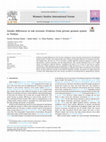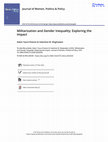Edited Books by Adem Yavuz Elveren
Using two novel datasets of the size of the informal economy and income inequality, this study pr... more Using two novel datasets of the size of the informal economy and income inequality, this study provides evidence on the nexus of informality and inequality with particular attention to the feminization of labor, a phenomenon closely related to labor market informalization. Using annual crosscountry panel data from 125 countries for 1963-2018, the study reveals a relationship between the size of the informal sector and income inequality, which is more likely to be negative in richer countries and positive in poor ones. It also shows that, while higher women's labor force participation is associated with lower income inequality, this negative correlation is cancelled by the presence of an informal sector.
Feminist research has revealed significant relationships between militarization, patriarchy, and ... more Feminist research has revealed significant relationships between militarization, patriarchy, and gender inequality. This paper takes that research forward through an empirical analysis of the impact of militarization on gender inequality and on women's participation in the labor market. Using the Gender Inequality Index and the Global Militarization Index for the period of 1990-2017 for 133 countries, the paper shows that higher militarization is significantly correlated with higher gender inequality and lower level of female labor force participation rate, controlling for major variables such as conflict, democracy level, regime type, fertility rate, and urbanization rate. The results are significant in the case of Islam and MENA countries, and with respect to countries with different income levels.
Gender and Society in Turkey: The Impact of Neo-Liberal Policies, Political Islam and EU Accession
Papers by Adem Yavuz Elveren

Women's Studies International Forum, 2023
Evidence on gender differences in risk aversion is ambiguous. Using actual data of participants i... more Evidence on gender differences in risk aversion is ambiguous. Using actual data of participants in the Individual Pension System in Türkiye, this study provides some evidence of the gender differences in investment decisions. The findings show that men are 17.6 % less likely to exhibit high-risk tendencies compared to women. Age demonstrates a positive association with risk-taking behavior. Also, married individuals have a 35 % higher chance of partaking in high-risk behavior. Nonetheless, this effect is 16 % lower for men than for women. Furthermore, college graduation raises the probability of high-risk behavior by 24 %, while income exhibits a negative impact, decreasing the likelihood of belonging to a high-risk group. When accounting for socioeconomic factors, the direct influence of gender on risk behavior diminishes. Notably, the presence of a higher proportion of women with college degrees and lower incomes contributes to risk-taking behavior independently of gender.
Using a relatively large time-varying crosscountry panel dataset of fiscal policy responses to th... more Using a relatively large time-varying crosscountry panel dataset of fiscal policy responses to the Covid-19 pandemic, this paper examines the relationship between military spending persistency and the size of the fiscal stimulus packages. The results suggest that countries with more persistent military spending have had smaller fiscalstimulus packages during the Covid-19 pandemic.

Based on Arrighi, we empirically investigate whether financialization and militarization are mutu... more Based on Arrighi, we empirically investigate whether financialization and militarization are mutually reinforcing phenomena in the United States. Military spending during the 1950-1960s in the United States counteracted the stagnation of the monopolistic stage of capitalism. Monopoly capital was transformed into finance monopoly capital as the intensity of financial capital increased during the late 1970s in response to stagnation. Considering alternative financialization variables and the profit rate in the financial sector, and using several parametric and nonparametric methods, we found a significant relationship between financialization and militarization in the United States for 1949-2019. The results suggest that the rise in financialization is parallel to the decline in the profit rates, leading to larger military expenditure in total, but with relatively smaller share in GDP.
While some economic models exist on the nexus of military spending and economic growth, and compr... more While some economic models exist on the nexus of military spending and economic growth, and comprehensive theory on the mechanisms through which militarization affects gender inequality, there are no structural models to show how military spending affects economic growth through gender inequality. This paper introduces a feminist-Kaleckian model to examine this mechanism. The main implication of the suggested model is that higher military spending is likely to increase gender inequality, and thereby reduce economic growth. This is because the marginal propensity to consume between men and women is different and military spending reduces the productive capacity of the economy in the long run.
This study empirically investigates the link between militarization and women's labor force parti... more This study empirically investigates the link between militarization and women's labor force participation rate, and gender inequality. Applying a panel cointegration method for 74 countries for 1990-2017, the study demonstrates the impact of militarization for different country groups, showing a significant negative association between indicators of militarization and women's labor force participation, and gender equality. The findings suggest that militarization is likely to decrease women's labor force participation and increase gender inequality. When considered with the previous literature, an implication of the study is that militarization contributes to lower economic growth via the channel of higher gender inequality.
International Econometric Review, 2023
It is expected that increasing female labor force participation (FLFP) rate, due to the gender wa... more It is expected that increasing female labor force participation (FLFP) rate, due to the gender wage gap, reduces the unit labor costs, and therefore increases profit rates. Using a dataset of 130 countries for 1990-2019, this paper shows that while FLFP increases profit share in highincome countries, it reduces in middle-income countries. However, for both middle-and highincome countries, FLFP cannot prevent the overall tendency in profit rates to decline caused by a consistent decline in output-capital ratio.
World Journal of Applied Economics, 2022
While there has been sizable literature on the effect of financial development on growth, inequal... more While there has been sizable literature on the effect of financial development on growth, inequality, and poverty, there are fewer studies on its impact on female labor force participation or women's wellbeing. Using a novel dataset, this paper investigates the association between the dimensions of financial development and female labor income share for 156 countries for the period of 1991-2019 to contribute to the literature on the role of financial development in improving women's wellbeing. The findings show that financial development is positively associated with women's income in highincome countries but not in low-income countries. The main implication of the study is that financial development in poor countries is not sufficiently inclusive enough to create economic opportunities for women.

Feminist scholars have long argued that militarism and patriarchy are linked. To date, however, t... more Feminist scholars have long argued that militarism and patriarchy are linked. To date, however, the relationship between militarization and gender inequality has not been empirically tested. Using the Gender Inequality Index and the Global Militarization Index for the period of 1990-2017 for 133 countries, we put the spotlight on militarization to show how it reflects and contributes to gender inequality (in terms of health, education, political representation, and labor force participation). Our article shows that higher militarization is significantly correlated with higher gender inequality, controlling for major variables such as the military in politics, the proportion of parliamentary seats held by women, conflict, democracy level, and regime type. Among other results, we find that higher representation of women in parliament correlates with less military spending. The results are significant in the case of Muslim majority countries and MENA countries, and with respect to countries with different income levels.
Defence and Peace Economics, 2020
This paper aims to contribute to the theoretical discussions on the effect
of military spending o... more This paper aims to contribute to the theoretical discussions on the effect
of military spending on the economy. To this end, it first modifies the
circuit of capital model proposed by Duncan Foley in 1982, which represents
money value stock-flow relations for capital in Capital Volume II.
Foley’s model is extremely useful for examining the relationship between
military spending and the rates of profit as it allows one to specify the
parameters in both the military and civilian sectors. By incorporating the
military sector, the adapted model shows that a larger military sector is
associated with a higher rate of profit. Second, the paper provides some
empirical evidence on the US for 1968–2008 for the main proposition of
the theoretical model.
Using two novel datasets of the size of the informal economy and income inequality, this study ex... more Using two novel datasets of the size of the informal economy and income inequality, this study examines the effect of informality on income and wage inequality with special attention to the rates of profit. Covering 86 countries for 1960-2016, the study shows that informality and the rates of profit are positively associated with income inequality; however, the positive impact of profit rate on income inequality decreases as the size of informal economy increases.
This study examines the gender dimension of the brain drain in Turkey, drawing on the results of ... more This study examines the gender dimension of the brain drain in Turkey, drawing on the results of an online survey to argue that the gender inequality present in sending countries can serve as a push factor in women's decisions to migrate and return or not return. The results indicate that the gender gap in the labor market in Turkey is an important factor in shaping the return intentions of female Turkish professionals and students living abroad. The findings reveal a gender gap in return intentions independent of other main factors, such as age, field of study/occupation, or duration of stay.
This article provides evidence of the effect of military expenditures on the rate of profits by f... more This article provides evidence of the effect of military expenditures on the rate of profits by focusing on 32 major countries for the period of 1963–2008 by using data from the Extended Penn World Tables, the University of Texas Inequality Project Estimated Household Income Inequality, the World Development Indicator, and the Stockholm International Peace Research Institute. The article employs a Generalized Method of Moment model within a Marxist framework. Findings show that military expenditures have positive effect on the rate of profits. It is also showed that increasing income inequality increases the rate of profits. Finally, the findings suggest that while military expenditures have a positive effect on the profit rates in the case of both arms-exporting countries and net-arms exporters, the relationship is not that significant in the case of arms-importing countries.
The article examines the effect of the feminization of labour on profit rates and capacity utiliz... more The article examines the effect of the feminization of labour on profit rates and capacity utilization by employing an indirect and two-stage least squares models for 21 OECD countries during the 1970–2008 period. Findings show that higher women's labour force participation rates and gender wage gap lead to higher profit rates.

This paper examines the effect of military expenditures on economic growth by utilizing dynamic p... more This paper examines the effect of military expenditures on economic growth by utilizing dynamic panel data analysis for 82 countries for the period of 1988–2008. Considering the possible effect of inequality on the military expenditures–economic growth nexus, this paper incorporates inequality along with its interaction with human capital into an augmented Solow growth model. The general finding is that military expenditures have a negative impact on economic growth, valid for several model specifications and sensitivity analyses. The negative impact holds when heterogeneity stemming from different country groups (e.g., development level, arms trade, fuel dependency) is considered. Also, the findings show that negative impact of military expenditure on growth for arms exporter and/or arms importer countries is weaker than those for other countries. Regarding income inequality and human capital, the findings suggest that human capital has a positive effect on growth, as expected. Income inequality on the other hand, has negative direct effect on economic growth. Considering these two variables together, the findings show that income inequality deteriorates growth for lower levels of human capital, whereas the impact of inequality on growth turns out to be positive for higher levels of human capital.









Uploads
Edited Books by Adem Yavuz Elveren
Papers by Adem Yavuz Elveren
of military spending on the economy. To this end, it first modifies the
circuit of capital model proposed by Duncan Foley in 1982, which represents
money value stock-flow relations for capital in Capital Volume II.
Foley’s model is extremely useful for examining the relationship between
military spending and the rates of profit as it allows one to specify the
parameters in both the military and civilian sectors. By incorporating the
military sector, the adapted model shows that a larger military sector is
associated with a higher rate of profit. Second, the paper provides some
empirical evidence on the US for 1968–2008 for the main proposition of
the theoretical model.
of military spending on the economy. To this end, it first modifies the
circuit of capital model proposed by Duncan Foley in 1982, which represents
money value stock-flow relations for capital in Capital Volume II.
Foley’s model is extremely useful for examining the relationship between
military spending and the rates of profit as it allows one to specify the
parameters in both the military and civilian sectors. By incorporating the
military sector, the adapted model shows that a larger military sector is
associated with a higher rate of profit. Second, the paper provides some
empirical evidence on the US for 1968–2008 for the main proposition of
the theoretical model.
Using the Gender Inequality Index and the Global Militarization Index for the period of 1990-2017 for 133 countries, the paper shows that higher militarization is significantly correlated with higher gender inequality and lower level of female labor force participation rate, controlling for major
variables such as conflict, democracy level, regime type, fertility rate, and urbanization rate. The results are significant in the case of Islam and MENA countries, and with respect to countries with different income levels.
ncome inequality, this study provides evidence on the nexus of informality and inequality with particular attention to the feminization of labor, a phenomenon closely related to labor market informalization. Using annual cross-country panel data from 125 countries for 1963-2016, the study reveals a relationship between the size of the informal sector and income inequality, which is more likely to be negative in richer countries and positive in poor ones. It also shows that, while higher women’s labor force participation is associated with lower income inequality, this negative correlation is cancelled by the presence of an informal sector.
Turkey defined itself as a social state in the 1961 Constitution, which assigned the state a major responsibility for providing all citizens with both preventive and curative services on the basis of equality, regardless of employment status and financial means. This “social state,” in terms of its historical evolution, has not expanded to bring about a universalist welfare regime. Rather, as in Southern European Model, a dual welfare system emerged: a highly fragmented and hierarchical social security regime existed alongside an informal system where family and informal welfare mechanisms played an important role (Bugra and Keyder 2006). The 1980 military coup marked the beginning of a new era for Turkish welfare regime with a market-oriented economic orthodoxy. This transformation reached its peak when the Justice and Development Party (AKP with its Turkish acronym) came to power in 2002. The most visible changes since that time have been in the social security system, education, and health provision.
In 1999, the government implemented a two-pillar system in which current social security institutions (the first pillar) were maintained after overhauls to their structures, along with private pension schemes which provided the support (the second pillar). A series of administrative reforms, including increasing the retirement age, have been implemented to rein in the deficit in the social security system. In 2006, the General Health Insurance (GHI) system was introduced. Also, a new institutional structure was established to integrate current social security institutions under a single roof. On the other hand, there are two main reforms in the education system. In 1997, the compulsory schooling was increased from five to eight years, and then from eight to twelve by the 2012 reform with the highly contested 4+4+4 law.
This chapter examines these changes with a focus on human capital. The second section discusses the characteristics of the broader social security system and explains the changes in pensions and health care. The third section explores the human capital dimension of the health care reform before drawing attention to changes in the education system. The fourth section provides a discussion on the future of the Turkish welfare system paying a special attention to implications for gender equality.
The book presents a general discussion on the economic models of the nexus of military spending and economic growth, as well as military Keynesianism and the military-industrial complex. Including an account of the Marxist crisis theories, it focuses on military spending as a counteracting factor to the tendency of rate of profit to fall. Using a range of econometric methods and adopting a Marxist perspective, this book provides comprehensive evidence on the effects of military spending on the rate of profit for more than thirty countries. The findings of the book shed light on the complex linkages between military spending and the profit rate by considering the role of countries in the arms trade.
Offering a Marxist perspective and an emphasis on quantitative analysis, The Economics of Military Spending will be of great interest to students and scholars of defence and peace economics, as well as Marxist economics.